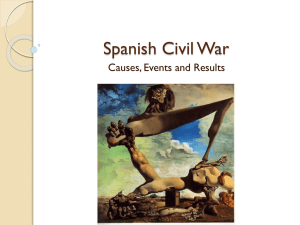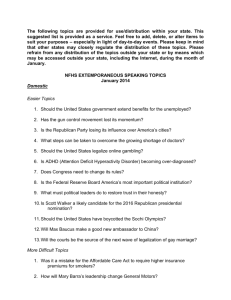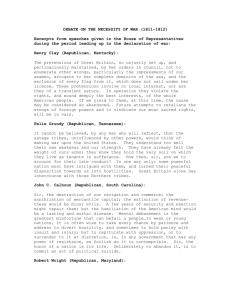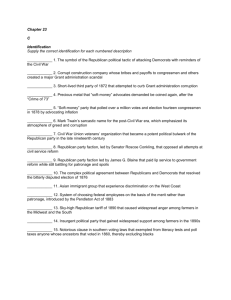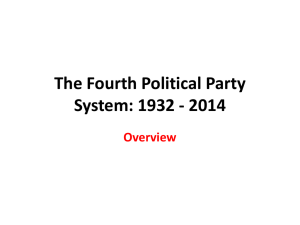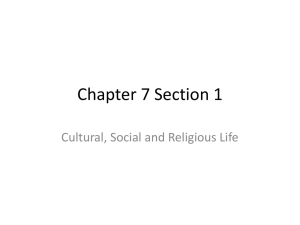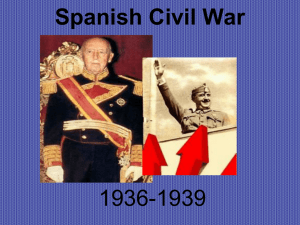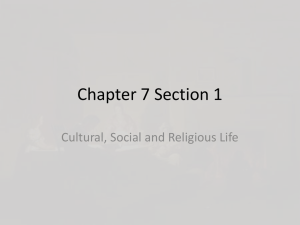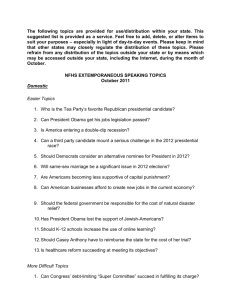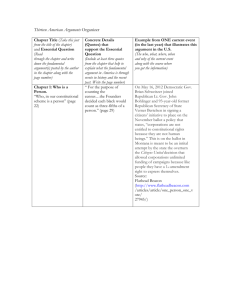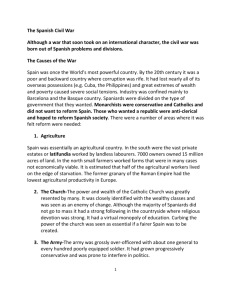Spanish Civil War
advertisement
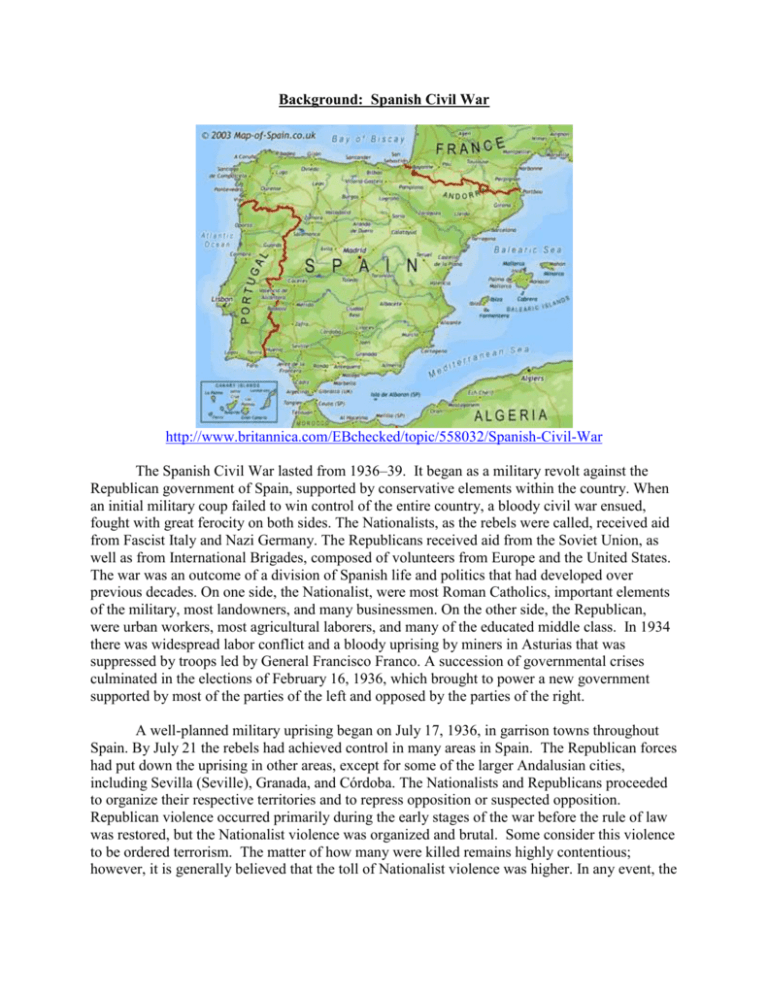
Background: Spanish Civil War http://www.britannica.com/EBchecked/topic/558032/Spanish-Civil-War The Spanish Civil War lasted from 1936–39. It began as a military revolt against the Republican government of Spain, supported by conservative elements within the country. When an initial military coup failed to win control of the entire country, a bloody civil war ensued, fought with great ferocity on both sides. The Nationalists, as the rebels were called, received aid from Fascist Italy and Nazi Germany. The Republicans received aid from the Soviet Union, as well as from International Brigades, composed of volunteers from Europe and the United States. The war was an outcome of a division of Spanish life and politics that had developed over previous decades. On one side, the Nationalist, were most Roman Catholics, important elements of the military, most landowners, and many businessmen. On the other side, the Republican, were urban workers, most agricultural laborers, and many of the educated middle class. In 1934 there was widespread labor conflict and a bloody uprising by miners in Asturias that was suppressed by troops led by General Francisco Franco. A succession of governmental crises culminated in the elections of February 16, 1936, which brought to power a new government supported by most of the parties of the left and opposed by the parties of the right. A well-planned military uprising began on July 17, 1936, in garrison towns throughout Spain. By July 21 the rebels had achieved control in many areas in Spain. The Republican forces had put down the uprising in other areas, except for some of the larger Andalusian cities, including Sevilla (Seville), Granada, and Córdoba. The Nationalists and Republicans proceeded to organize their respective territories and to repress opposition or suspected opposition. Republican violence occurred primarily during the early stages of the war before the rule of law was restored, but the Nationalist violence was organized and brutal. Some consider this violence to be ordered terrorism. The matter of how many were killed remains highly contentious; however, it is generally believed that the toll of Nationalist violence was higher. In any event, the spread of executions, murders, and assassinations on both sides reflects the great passions that the Civil War unleashed. The leadership of the Nationalists was gradually assumed by General Franco, leading forces he had brought from Morocco. On October 1, 1936, he was named head of state and set up a government in Burgos. The Republican government, beginning in September 1936, was headed by the socialist leader Francisco Largo Caballero. He was followed in May 1937 by Juan Negrín. The president of the Spanish Republic until nearly the end of the war was Manuel Azaña, an anti-Christian church liberal. Destructive conflict hurt the Republican effort from the outset. The many different groups within the Republican side could not get along and often fought each other. Both the Nationalist and Republican sides, seeing themselves as too weak to win a quick victory, turned abroad for help. Germany and Italy sent troops, tanks, and planes to aid the Nationalists. The Soviet Union contributed equipment and supplies to the Republicans, who also received help from the Mexican government. In August 1936, France joined Britain, the Soviet Union, Germany, and Italy in signing a nonintervention agreement that would be ignored by the Germans, Italians, and Soviets. About 40,000 foreigners fought on the Republican side in the International Brigades largely under the command of the Communists, and 20,000 others served in medical or auxiliary units. By November 1936 the Nationalists had advanced to the outskirts of Madrid. They laid siege to it but were unable to get beyond the University City area. They captured the Basque northern provinces in the summer of 1937 and then Asturias, so that by October they held the whole northern coast. A war of attrition began. The Nationalists drove a front eastward through Teruel, reaching the Mediterranean and splitting the republic in two in April 1938. In December 1938 they moved upon Catalonia in the northeast, forcing the Republican armies there northward toward France. By February 1939, 250,000 Republican soldiers, together with an equal number of civilians, had fled across the border into France. On March 5 the Republican government flew to exile in France. On March 7 a civil war broke out in Madrid between communist and anticommunist factions. By March 28 all of the Republican armies had begun to disband and surrender, and Nationalist forces entered Madrid on that day. The number of persons killed in the Spanish Civil War can be only roughly estimated. Nationalist forces put the figure at 1,000,000, including not only those killed in battle but also the victims of bombardment, execution, and assassination. More recent estimates have been closer to 500,000 or less. The bombing of Guernica was particularly damaging. This does not include all those who died from malnutrition, starvation, and war-engendered disease. The political and emotional effects of the war spread quickly. Many in other countries saw the Spanish Civil War as part of an international conflict between—depending on their point of view—tyranny and democracy, or fascism and freedom, or communism and civilization. For Germany and Italy, Spain was a testing ground for new methods of tank and air warfare. For Britain and France, the conflict represented a new threat to the international peace that they were struggling to preserve, which in 1939 collapsed into World War II. The war also had mobilized many artists and intellectuals to take up arms. Among the most notable artistic responses to the war were the novels Man’s Hope (1938) by André Malraux, Homage to Catalonia (1938) by George Orwell, The Adventures of a Young Man (1939) by John Dos Passos, and For Whom the Bell Tolls (1940) by Ernest Hemingway, as well as Pablo Picasso’s painting Guernica (1937) and Robert Capa’s photograph Death of a Loyalist Soldier, Spain (1936).
